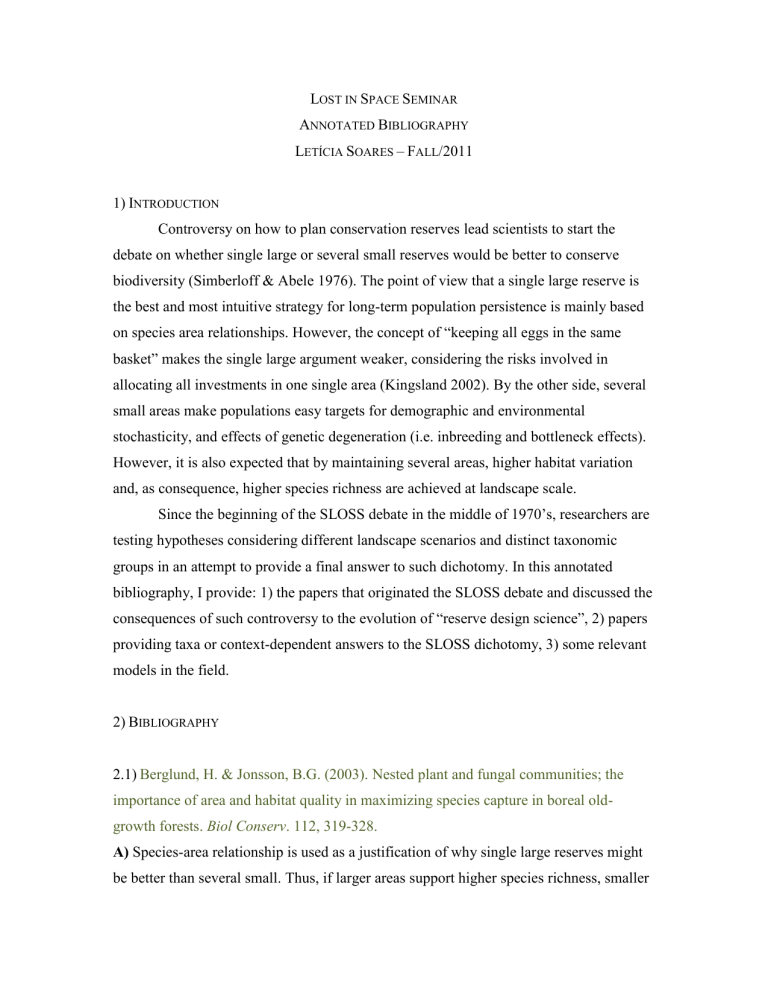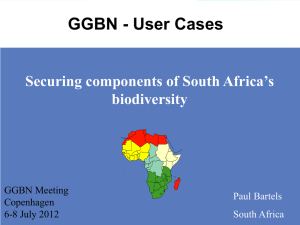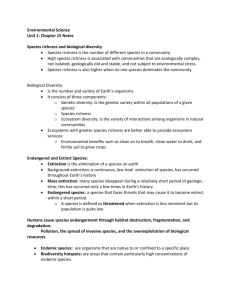Reserve design and the SLOSS debate

L
OST IN
S
PACE
S
EMINAR
A
NNOTATED
B
IBLIOGRAPHY
L ETÍCIA S
OARES
–
F
ALL
/2011
1) I
NTRODUCTION
Controversy on how to plan conservation reserves lead scientists to start the debate on whether single large or several small reserves would be better to conserve biodiversity (Simberloff & Abele 1976). The point of view that a single large reserve is the best and most intuitive strategy for long-term population persistence is mainly based on species area relationships. However, the concept of “keeping all eggs in the same basket” makes the single large argument weaker, considering the risks involved in allocating all investments in one single area (Kingsland 2002). By the other side, several small areas make populations easy targets for demographic and environmental stochasticity, and effects of genetic degeneration (i.e. inbreeding and bottleneck effects).
However, it is also expected that by maintaining several areas, higher habitat variation and, as consequence, higher species richness are achieved at landscape scale.
Since the beginning of the SLOSS debate in the middle of 1970’s, researchers are testing hypotheses considering different landscape scenarios and distinct taxonomic groups in an attempt to provide a final answer to such dichotomy. In this annotated bibliography, I provide: 1) the papers that originated the SLOSS debate and discussed the consequences of such controversy to the evolution of “reserve design science”, 2) papers providing taxa or context-dependent answers to the SLOSS dichotomy, 3) some relevant models in the field.
2) B
IBLIOGRAPHY
2.1) Berglund, H. & Jonsson, B.G. (2003). Nested plant and fungal communities; the importance of area and habitat quality in maximizing species capture in boreal oldgrowth forests. Biol Conserv . 112, 319-328.
A) Species-area relationship is used as a justification of why single large reserves might be better than several small. Thus, if larger areas support higher species richness, smaller
areas are characterized as being a subset of the total species pool, and nested communities are expected. The authors tested for non-random patterns of nestedness in order to investigate the effects of habitat quality and patch size on plant and fungal community organization.
B) They recorded species occurrence at two different scales, plot level and patch level.
The plot level represented a circular area of 0.1 ha in the center of the patches. They surveyed vascular plants, mosses, corticoid and polyporous fungus as well as crustose lichens.
C) They found that both fungus and plant assemblages were non-randomly nested organized, reinforcing the assumption that larger areas support higher species richness for both taxa. However, based on an analysis called the saturation index (ratio between the cumulative-species area curves for patches increasing and decreasing in size), the authors concluded that small patches accumulate species faster than larger ones. The analysis at plot level indicated that species were nested, which suggests that differences in habitat quality between areas, regardless the size, may have an important role on the organization of plant and fungal assemblages.
D) The authors would strength their findings by improving the description of the sampling methods. The survey method for all groups is not well defined. Even though they do mention their criteria to account for fungal species, for a lector that does not have an idea of how the boreal forest in Sweden looks like, it is hard to figure out how feasible is to account for all vascular plants and mosses in the plots.
E) The paper provides an important finding about the influence of habitat quality on the
SLOSS discussion. The idea that the effects of habitat quality on species occurrence must be taken into account, even though larger areas harbor more species, suggests that decision making processes must go beyond the debate area and configuration, and take into account habitat quality.
2.2) Dapporto, L. & Dennis, R.L.H. (2008). Island size is not the only consideration.
Ranking priorities for the conservation of butterflies on Italian offshore islands. J Insect
Conserv . 12, 237-249.
A) The paper addresses whether SLOSS islands are more important for butterfly conservation in shore islands in the Mediterranean region.
B) The authors use data on species richness, rarity, endemicity and community organization to estimate the importance of different sized islands on butterfly conservation.
C) Even though the largest island presented higher species richness, species assemblages were not organized as non-random nested subset in islands, indicating that island size is not important in determining species richness. Isolation revealed the most important landscape feature determining species richness. Endemicity was explained by neither isolation nor island size.
D) The authors try to apply an index to measure the conservation importance of the studies islands, and the connection of this approach with the main goal of the study is not well established.
E) The study provides empirical evidence that the simplistic approach that area size is the best descriptor of species richness might be unrealistic. Additionally, it evidences that species assemblages in archipelagos cannot just be viewed as nested subsets of a richer biota.
2.3) Ferraz, G., Nichols, J.D., Hines, J.E., Stouffer, P.C., Bierregaard, R.O. & Lovejoy,
T.E. (2007). A large-scale deforestation experiment: effects of patch area and isolation on
Amazon birds. Science . 315, 238-240.
A) The study investigates the effect of area, isolation and dispersal ability on the probabilities of occurrence, extinction and colonization of 55 passerine species in an experimentally induced fragmented landscape in the central Amazon forest.
B) Data used consists on presence/absence of 55 well-sampled bird species during 13 years. Mist net surveys were conduced in an area of experimental fragmentation, with patch areas of 1, 10, 100, 500 and 600 ha. Three experienced ornithologists classified species dispersion abilities.
C) For some species, regardless the dispersal ability, increase in patch isolation raised extinction probabilities, while for most of them the isolation effect was not strongly associated with extinction. Most of the species had their extinction probabilities increased
with the reduction of patch area, and some of these area-sensitive birds were not affected by patch isolation. This indicates that colonization does not influence extinction probabilities, and some species intrinsically do not occupy small patches.
D) The study is based on a long-term survey in an experimentally fragmented area. The long term data makes improves the analysis robustness, and the origin of the study area provides landscape change information relevant to the inferences made (i.e. forest regrowth). Additionally, the modeling approach used offers an estimate of uncertainty associated with the estimated parameters.
E) The authors provide valuable information on how landscape configuration might affect a large assemblage of species. The strong area effect on the patterns of bird occupancy in a fragmented landscape might shed light on what priorities may be in a similar context of that studied in the paper.
2.4) Hattori, A. & Shibuno, T. (2010). The effect of patch reef size on fish species richness in a shallow coral reef shore zone where territorial herbivores are abundant. Ecol
Res . 25, 457-468.
A) Species-area relationship (SAR) is used to investigate whether one single large or several small reef patches harbor higher species richness of damselfishes (Pomacentridae family).
B) The authors used aerial photographs combined with in situ measures, to estimate reef patch size. They accounted for species richness and abundance of damselfishes in reef patches, and used published information to classify species food habitats and territoriality.
C) An assemblage of reef patches contains more species of damselfishes than one single reef of the same area. Territorial herbivore damselfishes are known to be stronger competitors. Because of their territoriality, they require larger areas and are absent of smaller patches. Therefore, where stronger competitors are (larger patches), species richness tends to be reduced due to excluding competitive interactions.
D) The authors use different models to determine SAR, and rank them, providing a better idea of how species richness increases when patch area is raised. Some assumptions in the introduction must not be seen with the pragmatism they state. For instance, they
erroneously affirm that the SLOSS debate for terrestrial ecosystem is well resolved, moving towards a consensus that larger areas are the best alternative.
E) The study takes into account the relevance of interspecific interactions on solving the
SLOSS dichotomy.
2.5) Hoyle, M. & Harborne, A. (2003). Mixed effects of habitat fragmentation on species richness and community structure in a microarthropod microecosystem. Ecol Entomol.
30, 684-691.
A) The authors experimentally simulate fragmentation in a micro-scale (moss habitat), creating three different scenarios: 1) several small moss patches; 2) single large patches of moss, with area twice or three times the size of the smaller patches; 3) moss patch inserted in a “mainland moss”.
B) Data used consisted on richness, abundance and composition of species in a community of microarthropods, focusing on mites and collembolans.
C)
Whether “moss landscape” had single large or several small patches presented no effect on species richness, abundance or composition of mites and collembolans.
However, species richness was higher on the patch inserted in the moss matrix, suggesting that dispersal might be relevant.
D) The authors set a time interval of six months between experimental fragmentation and arthropod sampling. Considering the micro scale involving the study, it is not clear why such time interval was chosen. The authors should have replicated the experiment in time, setting different time intervals and accounting for variances through time.
E) This is an extraordinary study due to the scale it focuses on. The idea of using micro landscapes to test hypothesis involving the SLOSS dichotomy is interesting, useful, cheap and non-invasive.
2.6) Kingsland, S.E. (2002). Creating a science of nature reserve design: Perspectives from history. Env Model Asses . 7, 61-69.
A) The author provides a philosophical analysis based on the history of methods directed to design reserves, on the ecological theories involving the debate around nature reserves, and on the advances in the field provided by modern computational methods.
B) The paper is an essay based on bibliographic review about science history, ecological theories and decision-making processes.
C) Kingsland review the history behind the SLOSS debate, taking into account the evolution of the scientific though since the debate began in the 1970s. She explains why the SLOSS debate remain controversial, stating that scientists still focus on generalizations, while the solution of such debate is specific and dependent of many different factors such as what is being preserved and where, as well as the relative value of different species.
D) The strength of the paper remains in the deep historical analysis contextualizing the
SLOSS debate.
E)
The importance of this publication is centered on Platt’s ideas (Platt 1964) of why some fields of research advance faster than others. When Kingsland’s paper was published in 2002, the SLOSS debate was as it is today, a well known problematic controversy. However, Kingsland provides an explanation for why SLOSS is still an unresolved debate, even arguing that some theories supporting the debate lack on basic scientific methodology proposed by Popper (i.e. scientific results should be tested and replicable).
2.7) McCarthy, M.A., Thompson, C.J., Moore, A.L. & Possingham, H.P. (2011).
Designing nature reserves in the face of uncertainty. Ecol Let . 14, 470-475.
A) Based on metapopulation theory, they modeled uncertainty associated to extinction rates for a single large reserve and when reserve area is divided in subsets. They formulate two main types of models, one including dispersion among patches, and the other excluding this factor.
B) The study is based on theoretical models, and no empirical data were used.
C) Reserve design is independent of uncertainty on extinction rates, but is dependent of aspiration.
Aspiration is defined as the time taken to a population goes extinct. When dispersal is not considered, the number of reserves is determined by aspiration and varies with extinction risk. Lower extinction risk combined with higher aspiration drives to a larger number of reserves. Although, when extinction risk is high and aspiration is
increased, the number of reserves is reduced. When dispersal is considered, patch size is inversely related with the optimal number of reserves.
D) Although the models are well presented and the inclusion of parameters justified under the SLOSS debate, adding the effect of isolation on models would provide an even more applicable method for reserve design.
E) As far as the literature review I held revealed, this paper is the first one to present a solution for the SLOSS controversy that is not taxa or context dependent.
2.8) Ovaskainen, O. (2002). Long-term persistence of species and the SLOSS problem. J
Theor Biol . 218, 419-433.
A) Ovaskainen uses a metapopulation approach to access two optimal scenarios in the
SLOSS debate. The optimal scenarios are (1) maximum persistence of the metapopulation, and (2) maximum metapopulation capacity, which is determined by the combination of persistence and fraction of occupied patches. In his models, in order to determine where these two optimal scenarios are present in the continuous between single large and several small strategies, he considers the parameters of immigration, emigration and extinction rates, as well as patch number and area.
B) The study is based on theoretical models, and no empirical data were used.
C) Demographic (a) and environmental (b) stochasticity are considered as major threats for the two optimal scenarios. If a population is small, short series of random deaths are necessary to lead the population to extinction (a). Considering the positive correlation between area and population size, it is expected that larger areas buffer the risk of environmental stochasticity, reducing extinction probabilities. However, environmental stochasticity imposes a risk caused to environmental fluctuations, being a major threat for populations concentrated in single patches. If individuals are organized in metapopulations, such extinction risk is spread among the patches. But, even though the risk is shared, it is important to consider that spatial correlated extinction risk exists, and it may lead to the extinction of an entire assemblage of populations, if those are localized in small patches that do not harbor population sizes enough to survive a spatially correlated environmental fluctuation. The author concludes that to obtain the optimal scenario of higher persistence, an intermediate strategy (a mix of small and large patches)
might be the best. Additionally, if the objective is metapopulation capacity, a network of few larger patches is the best alternative.
D) The author provides a rich commented review of the SLOSS debate by the year of
2002. The models are well stated and described. The metapopulation approach used is adequate given the organization of populations in space in modified landscapes. I believe the main problem of the paper, which is pointed out by the author, is that it does not take into account habitat heterogeneity, assuming that all patches are of equal quality for species.
E) The major contribution of the paper is that the role of patch area under a metapopulation perspective is well defined when determining the number of patches used to reduce extinction risk.
2.9) Schippers, P., Grashof-Bokdam, C.J., Verboom, J., Baveco, J.M., Jochem, R.,
Meeuwsen, H.A.M., Van Adrichem, M.H.C. (2009). Sacrificing patches for linear habitat elements enhances metapopulation performance of woodland birds in fragmented landscapes. Landscape Ecol . 24, 1123-1133.
A) They test the hypotheses that mixed landscapes presenting small and large patches, as well as linear components, are more ecologically advantageous (i.e. synergy) than landscapes composed only by large patches.
B) Population dynamics and survivorship of the territorial middle spotted woodpecker are modeled in artificial landscapes with different configuration, but same amount of habitat area.
C) Metapopulation survivorship is higher when landscape is composed by a mix of small and large patches connected by linear elements. Also, when such linearity is absent, survivorship decreases in both small and large patches, suggesting that survivorship of species with limited dispersal ability might be improved by the existence of connection among patches.
D) The concept of synergy used by the authors is not well defined and of unnecessary use. Since they used the information on territory size for one species, it would be important to show how the models behave when empirical data is applied.
E) This study supports the idea that the solution for the SLOSS debate is not a
dichotomy. It reinforces the idea that the answer for SLOSS is species-dependent, and might be reached through the application of mixed strategies.
2.10) Simberloff, D.S. & Abele, L.G. (1976). Island biogeography theory and conservation practice. Science.
191, 285-286.
A) Supported by the theory of island biogeography, the authors tested the hypothesis that an assemblage of small refugees could present comparable richness when compared to a single large refugee.
B) Simberloff & Abele present an island biogeography model, analyzing the effect on species richness of dividing one single area in several patches (i.e. refugee).
They also use the results from a study on the effects of experimental isolation of red mangrove
( Rizophora mangle ) on the community of arboreal arthropods.
C) Both the theoretical model and the empirical data presented support the idea that several refugees might harbor comparable species richness of one single large refugee.
D) Even though they state awareness about the oversimplification on their models, the assumption that all species have comparable dispersion ability and survivorship in refugees is strong and false. The intrinsic differences among species may drive variations in the outcome of the proposed model, making the assumptions proposed questionable and vague.
E) This paper was the first one criticizing the general assumption that large reserves were always the best conservation strategy. It gave a starting point to the SLOSS debate.
2.11) Simberloff, D. & Gotelli, N. (1984). Effects of insularization on plant species richness in the Praire-forest ecotone. Biol Consev . 29, 27-46.
A) The authors address the question if plant species richness in a prairie-forest ecotone is greater in large patches than in a patch assemblage of same area. Additionally, they investigate species distributions on patches of different sizes.
B) They use five different data sets of plant species collected in prairie-forests in Illinois,
Minnesota and Iowa.
C) They found that an assemblage of patches have more species than one single large area. Clumping the species in patches and using randomizations, they concluded that smaller patches presented more rare species than single large ones.
D) The authors do not provide an ecological characterization of species composition, which makes weaker the assumption that higher species richness is similar to habitat quality and ecosystem functioning. Apparently, by the year the paper was published, no such information was available. However, an estimate of similarity or beta diversity among the study areas, would give an idea of how similar the species compositions were, and highlight which species added in the system were increasing richness in the assemblage of patches.
E) Despite the lack of biological information to better support the assumptions of the authors, the paper strengths the need of clarifying species responses to habitat insularization, and how it influences the design of conservation areas.
2.12)
Soulé, M.E. & Simberloff, D.S. (1986). What do genetics and ecology tell us about the design of nature reserves? Biol Cons . 35, 19-40.
A) The authors contest the utility of the SLOSS debate, taking into account ecological and genetic principles driving population persistence over time. The objective is to mitigate the SLOSS controversy, and provide a new guideline for reserve design based on
Minimum Viable Population (MVP) models.
B) Ideas are discussed under theoretical models in population genetics and empirical data from the literature.
C) Soulé and Simberloff argue that the debate of whether single large or several small reserves are better for species conservation is not a useful discussion, given that the critical factor for population persistence over time is an area size able to support minimum viable populations which are long term resistant to extinction threats.
Demographic stochasticity, genetic deterioration, social dysfunction and extrinsic factors are proposed to be the main processes driving extinction, with the strength of such effects being associated with small population sizes. They conclude that the SLOSS debate is no longer useful under this perspective, and that decision-making process in designing reserves should be drive by the estimate of an area necessary to harbor MVP of keystone
species.
D) The first weakness consists on the assumption that conservation is focused only on rare, threaten or endemic species. Conservation objectives are completely context dependent, and such assumption restricts the applicability of the MVP approach in designing reserves. Additionally, in the conclusions they state that the most prudent strategy is always to invest on largest reserves as possible. This conclusion lacks scientific evidence and it is unrealistic.
E) This paper consists a well-based argumentation against the usefulness of the SLOSS debate for designing conservation reserves.
2.13) Struebig, M.J., Kingston, T., Petit, E.J., Le Comber, S.C., Zubaid, A., Mohd-
Adnan, A. & Rossiter, S.J. (2011). Parallel declines in species and genetic diversity in tropical forest fragments. Ecol Lett . 14, 582-590.
A) In a landscape jeopardized by the expansion of palm oil plantation, the authors compare bat species richness and allelic genetic diversity of three species of bats with different ecological traits: a species with higher dispersion ability, the colonial
Rhinolophus lepidus , and two species with limited dispersion ability, the solitary
Rhinolophus trifoliatus and the colonial Kerivoula papillosa . Genetic diversity is compared within and between habitat patches. It is also tested if patch size and isolation are able to predict genetic diversity of the bat species.
B) Overall species richness was obtained from sampling using harp traps across set in transects.
Genetic diversity for the three bat species was assessed using microsatellite markers, due to their “ sensitive to fine-scale population variation and are one of the most powerful molecular tools used in conservation genetic research ” (Struebig et al . 2011).
For each species, a specific number of polymorphic loci was screened using PCR, followed by allele sequencing.
C) Patch area predicted species richness better than patch isolation. Species-area relationship explained diversity of specialist bats, however, the same metric showed weak power of explanation for generalist and edge-tolerant species. This finding explains why they found comparable richness in continuous forest and larger fragments (>650 ha), and why specialist richness was only comparable to continuous forest in fragments bigger
than 2500 ha. Fragments presented reduce allelic richness, and only patches of area superior of 5000 ha had the same level of richness of continuous forest. Allelic richness was not affected by fragmentation in the species with better dispersal ability ( R. lepidus ).
Patch size determined allelic richness in the specialist K. papillosa .
D) The paper answers the question it addresses assuming the simplification that only size and connectivity determine bat species diversity. They focus on resource use by the species, dividing bats in generalists and specialists. Considering they used this approach, patch quality, in terms of food resource abundance, would be an important metric to be considered in the study.
E) The importance of this study remains on the fact they use empirical data mainly based on genetic diversity to provide patch area thresholds for the maintenance of species diversity.
2.14)
Tjørve, E. (2010). How to resolve the SLOSS debate: Lessons from speciesdiversity models. J Theor Biol . 264, 604-612.
A) The author applies species-diversity models at different landscape contexts in an attempt to estimate the best scenario of reserves under the SLOSS debate. The speciesdiversity models are based on species-area relationship models employed for different scenarios of reserve area, number and connectivity. Special focus is given on the shape of species-area curves under different scenarios.
B) The study is based on theoretical models, and no empirical data were used.
C) In a scenario of fewer and larger reserves, the author predicts an increase in the species spatial aggregation and minimum-area requirements, as well as species similarities among reserves. Simultaneously, this scenario also predicts reduction on species abundance evenness and density among reserves. Thus, the fewer larger reserves would be more adequate if the conservation targets are rare species, and not maintenance of species richness at landscape level. The success of smaller reserves showed to be correlated with their connectivity, which also influenced the ideal number of smaller reserves. He concludes that the outcomes based on species area relationships are clear, and whether single large or several small reserves is the most adequate strategy depends on what is being the conservation objective.
D) Contrary to many publications about the SLOSS debate, this paper provides a clear position on what should be done in different scenarios. Most importantly, it assumes that the SLOSS controversy does not have a single solution, and criticizes studies that have been trying to give one single answer to the question of single large or several small.
However, that assured position might be rooted on the fact that what was presented was purely theoretical. The author would make his findings more reliable if he has applied empirical data using the presented models. Additionally, it is not clear how he generated the graphics, for instance, if those were generated based on data simulation or other technique.
E) The author used a well-debated concept (species area relationships) in ecology to attempt solving the SLOSS debate considering different landscape scenarios. The simplicity behind the theoretical approach he used allowed him to actually take positions on the SLOSS debate.
2.15) Tscharntke, T., Steffan-Dewenter, I., Kruess, A. & Thies, C. (2002). Contribution of small habitat fragments to conservation of insect communities of grassland-cropland landscapes. Ecol Appl . 12, 354-563.
A) The paper investigates the effects of habitat fragmentation on structuring and trophic interactions of insect communities in a mosaic landscape composed by native grasslands and crops.
B) They studied butterflies, legume-feeding herbivores and rape pollen beetles. They also accounted for the herbivores and beetles parasitoids. Butterfly survey was based on species sight in transects. Herbivores and their parasitoids were sampled dissecting flowers of cloves ( Trifolium pratense ) and vetches ( Vicia sepium ). Last instar larva of rape pollen beetles were collected on rape ( Brassica napus ) fields, and dissected in order to measure parasitism. Landscape structure was analyzed based on aerial photographs and field data.
C) Patch size was positively correlated with species richness for all taxa analyzed. For butterfly species, increase in patch size was correlated with the increase and decrease on the number of specialist and generalist taxa, respectively. Even though most herbivore species studied were specialists, species richness in this group was not proven to be
affected by patch size. However, the number of species of herbivore parasitoids was strongly correlated with patch area, indicating that fragmentation impact might be related to species trophic level. For the rape pollen beetles, parasitism may be dependent on the amount of natural grassland available, since in landscapes dominated by crops, beetles were more parasitized when close to the edge of the grassland patch.
D) The authors lack on make some methodological points more clear. For instance, the butterfly survey is questionable, since they do not provide empirical information showing the efficacy of visual samples for insect taxa in the study area. Additionally, it is not clear what is considered by landscape structure. In conclusion, trophic interactions were discussed, but the relationship among the taxa studied was under covered in a broader context of community ecology.
E) The strongest point of this study is the analysis of the effects of patch size on different trophic levels.
3) C ONCLUSIONS
At first sight the general answer for the SLOSS debate is “it depends”. The conclusion can look extremely disappointing considering that 35 years passed since the debate began. However, the SLOSS debate was already originated with the expectancy of a fixed single answer, which consisted a mistake and might explain the roots of such disappointment. Conservation per see is extremely taxa and context dependent.
Management strategies vary with budget, culture, climate, and ecological targets addressed (i.e. to preserve species richness vs . endemic or rare species) (Kingsland 2006).
The SLOSS controversy provided a main question and a starting point to investigate the best design of reserves, regardless the existence of any variation-source factor above mentioned. Theoretical models have been providing the best answers for the dichotomy of single areas or several small, even though these need to be improved to accomplish a larger possibility of landscape configurations. What the field needs right now are empirical applications of the models already developed, such as McCarthy et al . (2011).
4) R EFERENCES
Platt, J.R. (1964). Strong inference. Science, 146: 347-353.






